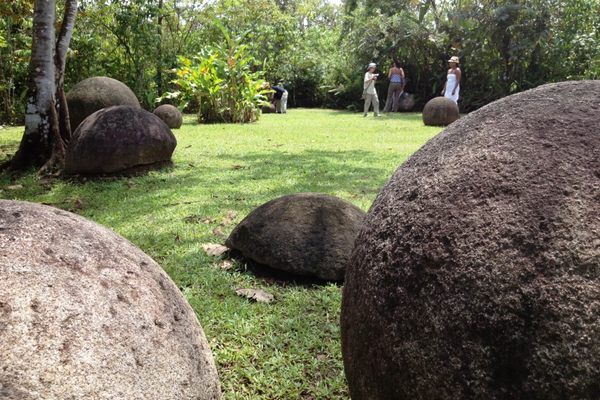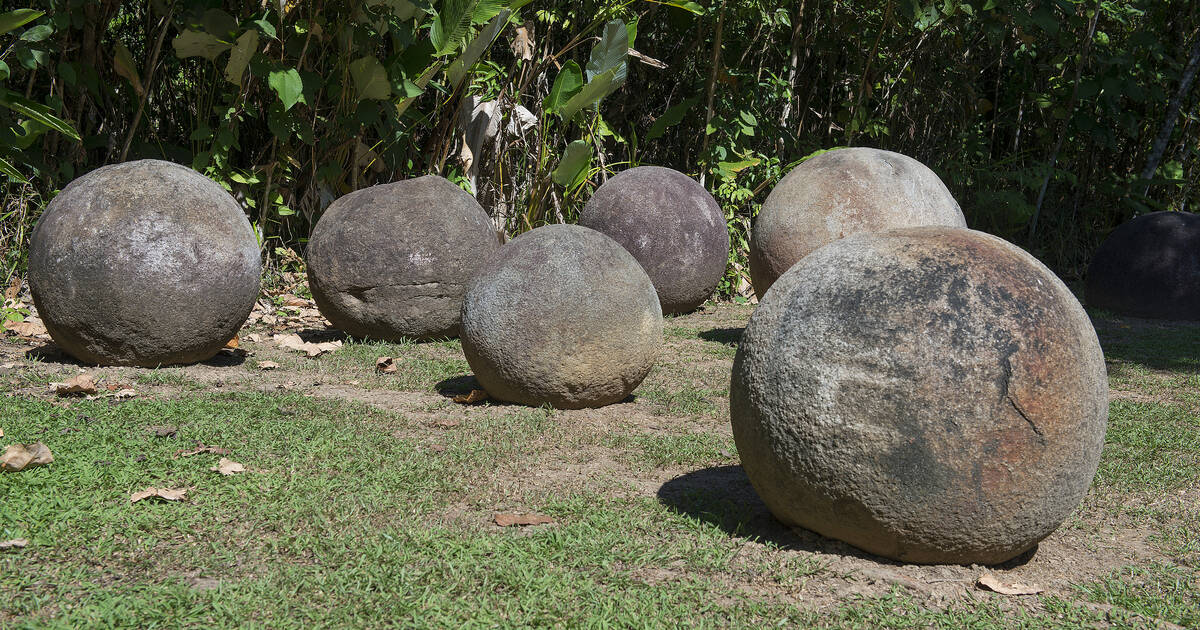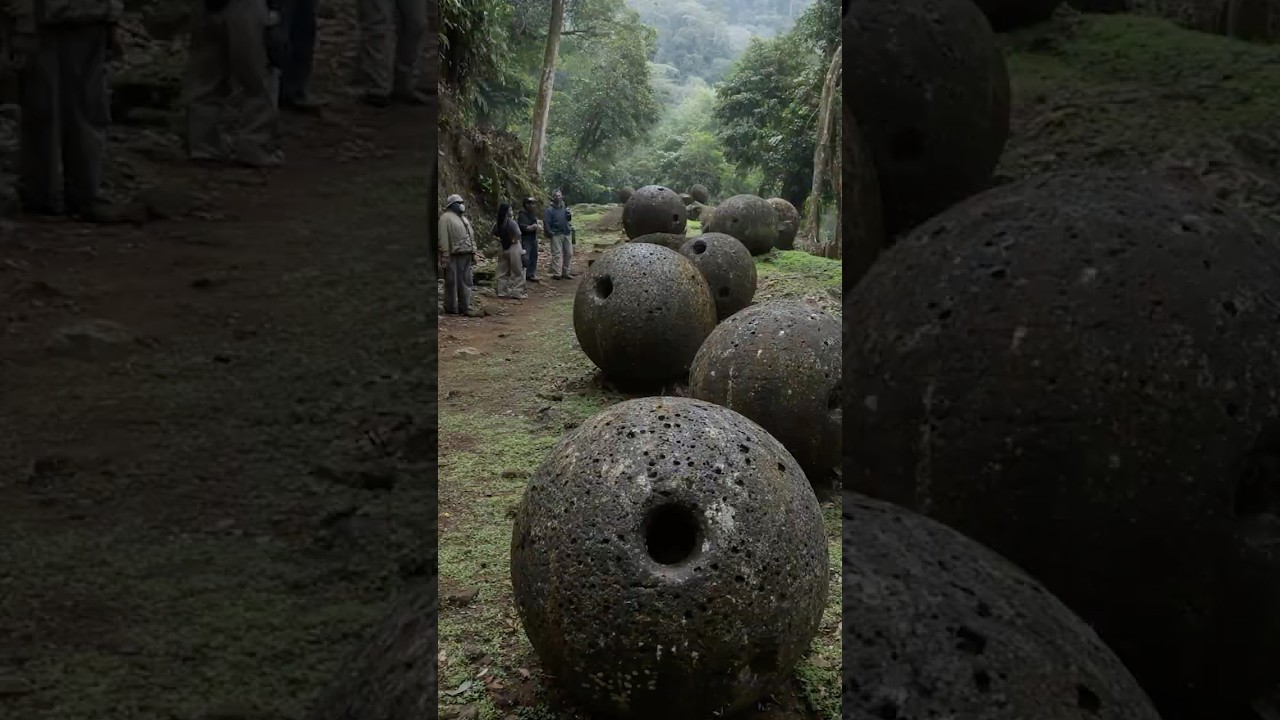Deep in the jungles of Costa Rica, scattered across riverbeds, banana plantations, and forest clearings, lie hundreds of perfectly round stone spheres—some small enough to hold in your hands, others so massive that even modern machinery struggles to move them. Their surfaces are smooth, their symmetry nearly flawless, and their origins shrouded in mystery. These enigmatic relics, some dating back more than 1,500 years, continue to baffle archaeologists and ignite debate around the world. How did ancient people—without advanced tools or technology—create such perfection in stone? And perhaps the greater question: why?

When the first of these spheres was uncovered in the 1930s by workers clearing land for a banana plantation, no one could have imagined that they were about to unearth one of archaeology’s most enduring enigmas. The fruit company, unaware of their significance, pushed many of them aside or even blew them up with dynamite, hoping to find gold rumored to be hidden within. But what they had destroyed were not mere rocks—they were ancient masterpieces. The surviving spheres, later studied by archaeologists, revealed an astonishing level of precision. Some were carved so perfectly round that they deviated less than two millimeters from absolute symmetry.
Radiocarbon dating of nearby artifacts places their creation between 500 and 1500 CE, during the Diquís culture’s peak in what is now southern Costa Rica. Yet, beyond this rough timeframe, almost everything else about the spheres remains unknown. They have no inscriptions, no obvious purpose, and no consistent placement. Some were found in clusters forming geometric alignments—triangles, straight lines, or circles—while others were buried alone, as if deliberately hidden. To this day, there is no definitive evidence explaining their purpose.

Experts agree that the spheres were made from three types of rock—granodiorite, gabbro, and limestone—all of which are extremely hard. Quarry sites have been identified miles away, suggesting that the stones were transported long distances, likely by rolling or dragging. But how the ancient Diquís people managed to shape and polish these massive orbs with such accuracy remains an open question. Without metal tools or machinery, their only options would have been stone hammers, sand, and water—methods that would have taken years to achieve even one near-perfect result.
Archaeologists have proposed several theories to explain their purpose. Some believe the spheres had astronomical significance, serving as markers for celestial events or seasonal changes. Their alignment with solstices and cardinal directions in some locations supports this view. Others suggest they symbolized power and prestige, representing the authority of tribal leaders. In Diquís society, where social hierarchy was strong, the spheres may have served as territorial markers or ceremonial objects denoting status. Still, none of these explanations account for their incredible precision—or why such monumental effort was poured into shaping simple, featureless forms.

Alternative researchers have ventured into more speculative territory. Some argue that the spheres could be remnants of a lost civilization with advanced knowledge of geometry and stonework—perhaps even connected to legends of Atlantis or other pre-Columbian global cultures. Others suggest they were created as navigational aids or energy conductors aligned with Earth’s magnetic fields, part of a forgotten system of ancient technology. While mainstream archaeologists reject these claims, the truth is that no one has yet found conclusive evidence to fully explain the mystery.
The mystery deepens when we consider that nearly identical stone spheres have been discovered in other parts of the world—such as the volcanic islands of the South Pacific, Scotland’s Highlands, and even Bosnia. Though smaller and carved from different materials, these orbs share striking similarities in form and precision. Could this be coincidence, or does it hint at a shared symbolic understanding that spanned cultures and continents? The notion that disparate civilizations, separated by oceans and millennia, might have independently crafted similar monuments challenges our assumptions about early human communication and cultural exchange.

In 2014, UNESCO recognized the Diquís stone spheres as a World Heritage Site, granting them protection and acknowledging their cultural importance. The decision came after decades of neglect, vandalism, and illegal sales to private collectors. Many of the spheres had been removed from their original settings, depriving archaeologists of crucial context. Some now sit in museums or as lawn ornaments in wealthy estates, far from the jungles that once hid them. Even so, ongoing excavations and digital mapping are helping researchers piece together patterns that could reveal their original function.
Recent studies using ground-penetrating radar and 3D scanning have identified foundations or stone platforms beneath some spheres, suggesting they were once part of larger complexes. This discovery points toward ceremonial or political use—possibly as components of ancient plazas or processional routes. Yet, the intentional placement of some spheres in seemingly random locations still defies easy categorization. Were they offerings to the gods? Boundary markers? Or expressions of an ancient mathematical language now lost to time?
One of the most haunting aspects of the stone spheres is their silence. Unlike Egyptian hieroglyphs or Mayan inscriptions, the Diquís people left no written record. Their culture vanished long before the Spanish arrived in the 16th century, leaving behind only these perfect, wordless monuments. To stand before them is to face a civilization that mastered geometry, engineering, and symbolism—and then disappeared without explanation.
For archaeologists, the mystery is as much about the people as the stones. How did a relatively small indigenous society accomplish such feats of craftsmanship with no known large-scale infrastructure? And why did they choose perfection—spheres without faces, symbols, or decoration—as their legacy? Perhaps, as some historians suggest, the very act of achieving symmetry represented spiritual balance or cosmic harmony. In many ancient cultures, the circle symbolized eternity, unity, and the divine order of the universe. The Diquís may have sought to manifest these concepts in physical form, turning stone into symbols of their worldview.
From orbit, satellite imagery reveals how the spheres form subtle patterns across the landscape—lines that appear to align with rivers, mountains, and even constellations. Some researchers propose that when viewed collectively, they form a map or a celestial diagram connecting sacred sites across Costa Rica’s southern plains. Others remain skeptical, attributing these alignments to coincidence. But the precision of their placement continues to raise eyebrows, suggesting that even if their builders didn’t possess modern tools, they did possess advanced knowledge of surveying and spatial design.
Today, the stone spheres of Costa Rica stand as silent ambassadors of an ancient mystery that refuses to fade. Their perfectly curved surfaces glint beneath the tropical sun, a reminder that the past still holds secrets beyond our grasp. Whether they were created for gods, rulers, or reasons long forgotten, their existence challenges our assumptions about human ingenuity. In every curve lies a question: how could such precision emerge from a world without metal, machines, or mathematics as we know it?
Perhaps that is why they continue to captivate us. They are not just artifacts—they are riddles carved in stone, timeless testaments to the creative and enigmatic spirit of humanity. Like the pyramids or the Nazca Lines, the stone spheres invite us to look deeper, to wonder not only about who made them but also about what drives us to create symbols meant to endure eternity.
Sources:
-
UNESCO World Heritage Centre – “Precolumbian Chiefdom Settlements with Stone Spheres of the Diquís”
-
Smithsonian Magazine – “The Mystery of Costa Rica’s Stone Spheres”
-
National Geographic – “The Perfect Spheres of the Diquís: Ancient Art or Astronomical Code?”
-
BBC Travel – “The Enigma of Costa Rica’s Mysterious Stone Balls”
-
Archaeology Magazine – “Decoding the Diquís Stone Spheres”
